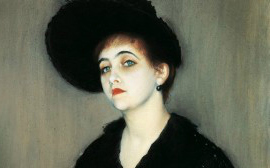 |
| A young Claude Debussy, as he would have appeared around the time he is believed to have scored Hymnis. |
The “astonished” staff, along with scores of fans of the late French romantic composer had all but given up hope on ever laying eyes on the manuscript again after it seemingly vanished following a sale at auction in 1926.
Speaking with Christie’s appraisers last month, Parisian specialist Andre Legendre reflected on the excited atmosphere experienced by the French department late last year:
“When we saw it and looked through the 28 pages, we were absolutely astonished..[it is] a piece of his youth, from which we already see the genius he will become.”The new manuscript contains 15 pages of previously unknown music, and would mark the second time Debussy would collaborate on a play written by Banville (there was Florise in c1882, followed the same year by Hymnis, and Diane au Bois in 1883).
During the time frame Hymnis is believed to have been written, Debussy would score no less than 12 of Banville’s poems, each time dedicating the music to his lover, the amateur soprano Marie Vasnier. Hymnis is no exception – an indiscreet marginalia on the cover page of the manuscript reads "à Madame Vasnier.”
 |
| Debussy's inamorata, inspiration, and to whom the score of Hymnis is dedicated, Marie-Blanche Vasnier. |
Leading Debussy scholars look to Hymnis as evidence of the torrid affair having been used as a source of inspiration for the music: the composer, for reasons unstated in his memoirs, opted to score only a portion of the comédie lyrique. Prior to this recent discovery, the only known musical setting of the work came from two sources
(from Christie’s:)
“...one for the Strophes of the first scene (‘Il dort encore, une main sur la lyre’ in the Martin Bodmer collection), the other from the beginning of scene 7, the Ode bachique (‘À toi Lyaeos’, formerly in the Toscanini Collection, sold at Sotheby's, 26 May 1983, lot 17, £14,000).
 |
| cover page with dedication to Mme. Vasnier. High resolution available at Christie's |
The present manuscript, untraced since it was sold at auction on 1 June 1926, has never been described in any of the catalogues devoted to Debussy. It is meticulously notated in brown ink and comprises, with new variants, the Strophes of scene 1 and the Ode Bachique, whilst also including three previously unknown sections:
- The duo for Anacreon and Hymnis in scene 1 (‘Sous nos pas le ciel a mis’), pp. 7-8.
- The song of Anacreon in scene 2 (‘Quand par un jour de soleil’), pp. 9-11, lacking the end of the fourth stanza and the fifth stanza.
- The final trio of scene 7 (‘Ah! nous sommes bénis‘), pp. 23-31.”
 |
| excerpt. High resolution available at Christie's |
The manuscript is a fair copy, believed to have been destined for the hands of Mme. Vasnier.
It is written in brown ink and appeared in the Christie’s catalogue under lot 13 and sold last month at auction for €112, 500, under it’s estimated hammer price of €120,00 -180, 000.
Just prior to the listing going live on the Christie’s website, the auction house arranged for a performance of the rediscovered work which it included (in truncated form) on a video uploaded to the site - no doubt geared toward highlighting for prospective buyers the exquisite beauty and historical significance of the recent find. It can be heard below (external link, opens in new window).
 |
| Christie's |

No comments:
Post a Comment